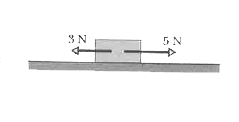Rank in order, from largest to smallest, the sizes of the friction forces →fa to →fc in these 5 different situation. The box and the floor are made of the same materials in all situations.
(a) 
(b) 
(c) 
(d) 
(e) 
fd<fb=fc=fc>fa
fc<fb=fd=fc>fa
fb=fc=fd=fc>fa
fb>fc=fd=fc>fa
The correct Answer is:D
fb>fc>fd>fe>fa Situations c ,d and e are all kinetic frIction, which does not depend on either velocity ot accerleration. Kinetic friction is smaller than the masimum static friction that is exerted in b, fa−0 because no friction is needed to keep the object at rest.
Topper's Solved these Questions
- TEST PAPERBOOK - ALLENCHAPTER - TEST PAPEREXERCISE - PHYSICS
4 Videos
- TEST PAPERBOOK - ALLENCHAPTER - TEST PAPEREXERCISE - PHYSICS
4 Videos
- SIMPLE HARMONIC MOTIONBOOK - ALLENCHAPTER - SIMPLE HARMONIC MOTIONEXERCISE - Example
1 Videos
- TEST PAPER 1BOOK - ALLENCHAPTER - TEST PAPER 1EXERCISE - PHYSICS
11 Videos
Similar Questions
Figure 8-3 shows four situations in which the same box is pulled by an appiled force →F up a frictionless ramp through (and then past ) the same vertical distance In each situation, The force has a magnitude of 10 N. In situations (b) and (d), the force is directed along the plane: in situations (a) and (c). it is directed at an angle ϕ=37∘ to the plane. as shown. Rank the situations according to the work done on the box in the vertical distance by the appiled force. Also, discuss whether answer depends on the initial speed of box or the presence of other forces.
View SolutionFigure8-5a shows two industrial spies sliding an initially stationary 225 kg floor safe a displacement →d of magnitude 8.50 m. The push →F1 of spy 001 is 12.0 N at an angle of 30.0∘ downward from the horizontal, the pull →F2 of spy 002 is 10.0 N at 40.0∘ above the horizontal. The magnitudes and directions of these forces do not change as the safe moves, and the floor and safe make frictionless contact.
(b) During the displacement, what is the work Wg done on the safe by the gravitational force →Fg and what is the work WN done on the safe by the normal force →FN from the floor ?
View Solution
Knowledge Check
Rank in order, from largest to smallest, the sizes of the friction forces →fa to →fc in these 5 different situation. The box and the floor are made of the same materials in all situations.
(a)
(b)
(c)
(d)
(e) AFd<Fb=Fc=Fe>FaBFc<Fb=Fd=Fe>FaCFb=Fc=Fd=Fe>FaDFb>Fc=Fd=Fe>Fa
AFd<Fb=Fc=Fe>FaBFc<Fb=Fd=Fe>FaCFb=Fc=Fd=Fe>FaDFb>Fc=Fd=Fe>Fa
A block lies on a floor. (a) What is the magnitude of the frictional force on it from the floor ? (b) If a horizontal force of 5N is now applied to the block. But the block dose not move. What is the magnitude of the fricition on it ? (c) If the maximum value fcmax of the static frictional force on the block is 10 N, will the block move if the magnitude of the horizontally applied force is 8 N? (d) If it is 12 N ? (e) What is te magnitude of the frictional force in part (c) ?
View SolutionA particle of m=5kg is momentarily at rest at x=att=. It is acted upon by two forces →F1 and →F2. Vec(F)1=70ˆj N. The direction and manitude of →F2 are unknown. The particle experiences a constant acceleration, →a,in the direction as shown in (figure) Neglect gravity.

a.Find the missing force →F2.
b. What is the velocity vector of the particle at t=10s?
c. What third force, →F3 is required to make the acceleration of the particle zero? Either give magnitude and direction of →F3 or its components.
View SolutionTwo sphere of mass m and M are situated in air and the gravitational force between them is F .The space around the masses is now filled with a liquid of specific gravity 3 .The gravitational force will now be (a) F (b) F/(3) (c) F/9 (d) 3F
View SolutionA moving particle of mass m is acted upon by five forces→F1,→F2,→–––(F)3,→F4 and →F5. Forces →F2 and →F3 are conservative and their potential energy functions are U and W respectively. Speed of the particle changes from Va to Vb when it moves from position a to b. Which of the following statement is/are true – (a) Sum of work done by →F1,→F4 and →F5=Ub−Ua+Wb−Wa
(b) Sum of work done by →F1,→F4 and →F5=Ub−Ua+Wb−Wa+12m(V2a−V2a)
(c) Sum of work done by all five forces =12m(V2b−V2a)
(d) Sum of work done by →F2 and →F3=(Ub+Wb)−(Ua+Wa)
View SolutionSuppose that the cantaloupe and table of Fig. 5-6 are in an elevator cab that begins to accelerate upward. (a) Do the magnitudes of →FTC and →FCT increase, decrease, or stay the same ? (b) Are those two forces still equal in magnitude and opposite in direction? ( c ) Do the magnitudes of →FCE and →FEC increase, decrease, or stay the same? (d) Are those two forces still equal in magnitude and opposite in direction?
View SolutionThe figure here shows three arrangements of an electron e and two protons p. (a) Rank the arrangement according to the magnitude of the net electrostatic force on the electron due to the protons, largest first. (b) In situation c, is the angle between the net force on the electron and the line labelled d less than or more than 45∘ ?

View SolutionThe figure here shows two horizontal forces acting on a block on a frictionless floor. If a third horizontal force →F3 also acts on the block, what are the magnitude and direction of →F3 when the block is (a) stationary and (b) moving to the left with a constant speed of 5 m/s ?

View Solution
